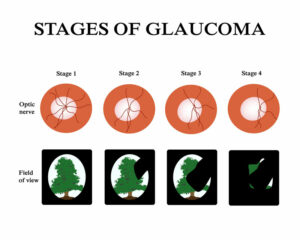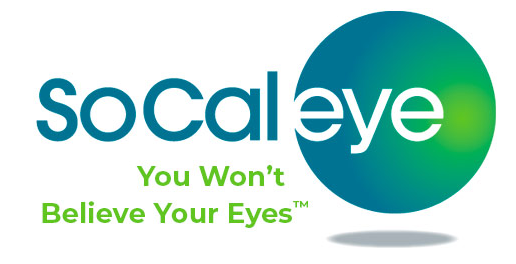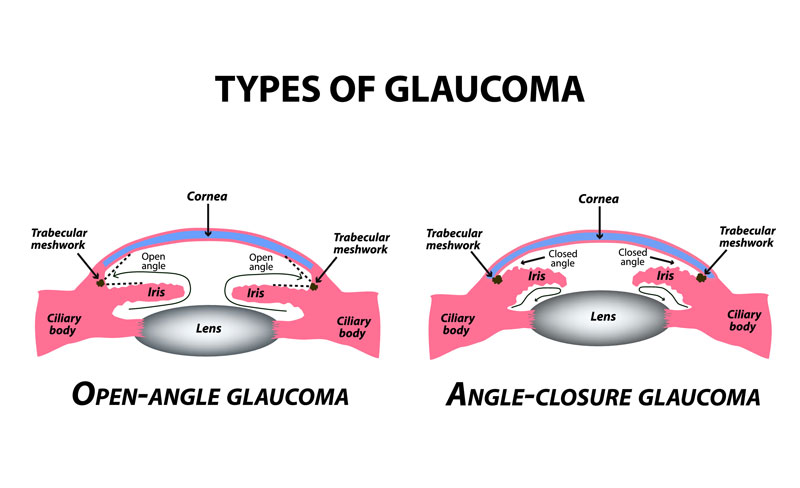
SoCal Eye Glaucoma FAQs: Glaucoma Doctors answer some of the most commonly asked questions related to Glaucoma and Glaucoma Treatment. All Glaucoma Treatment begins with a Consultation with a SoCal Eye Physician who will take time to answer all questions and ensure that the patient is comfortable with the individual care plan. If you have further questions please contact our office for a consultation.
What Are Different Forms of Glaucoma?
There are two main forms of glaucoma: open-angle; and angle-closure. There are also several other forms of glaucoma, including normal-tension, congenital, juvenile, and secondary.
Open-angle Glaucoma
Open-angle Glaucoma is the most common form of the disease accounting for 90% of all Glaucoma cases with close to 2.7 million Americans impacted by the condition. OAG is progressive and characterized by optic nerve damage. The most significant risk factor for the development and advancement of this form is high eye pressure. Initially, there are usually no symptoms, but as eye pressure gradually builds, at some point the optic nerve is impaired and peripheral vision is lost. Without treatment, an individual can become totally blind. The good news is that incidence of blindness has fallen dramatically over the past 20 years with significant advancements in detection and treatment.
Angle-closure Glaucoma
Angle-closure glaucoma may be acute or chronic. In acute angle-closure (also called closed angle) glaucoma, the normal flow of eye fluid (aqueous humor) between the iris and the lens becomes blocked. Symptoms may include severe pain, nausea, vomiting, blurred vision, and seeing a rainbow halo around lights. Acute angle-closure glaucoma is a medical emergency and must be treated immediately, or blindness could result in one or two days. Chronic angle-closure glaucoma progresses more slowly and can damage the eye without symptoms, similar to open-angle glaucoma.
Normal-tension Glaucoma
Normal-tension glaucoma occurs when eye pressure is normal, yet the optic nerve is damaged and peripheral vision is lost. Lowering eye pressure through medication sometimes slows the progress of the disease, but this type of glaucoma may worsen despite low pressure. The treatment is generally the same as for open-angle glaucoma.
Congenital / Juvenile Glaucoma
Glaucoma that affects infants born with defects that prevent the normal drainage of fluid from the eye is termed Congential. Juvenile glaucoma is open-angle glaucoma that affects children, adolescents, and young adults.
Secondary Glaucoma
This can be open-angle or closed-angle and is the result of some other medical condition in the eye or the body.
Who Is at Risk of Developing Glaucoma?
Glaucoma is a leading cause of blindness among African Americans and Hispanics in the U.S. Three times as many African Americans have glaucoma than Caucasians, and four times as many are blind. Between the ages of 45 and 64, glaucoma is fifteen times more likely to cause blindness in African Americans than in Caucasians. All people older than 60 are at a greater risk of developing glaucoma than people who are younger.
What are the Symptoms of Glaucoma?
 Most people with glaucoma, particularly those with open-angle glaucoma or normal-tension glaucoma, may have no or very minimal symptoms for years. It is probably not surprising that an estimated 50% of glaucoma cases are undiagnosed, emphasizing the need for regular eye examinations, beginning at age 40. An eye care professional will be able to detect signs of glaucoma before you can, and timely intervention is key to preventing disease progression and vision loss.
Most people with glaucoma, particularly those with open-angle glaucoma or normal-tension glaucoma, may have no or very minimal symptoms for years. It is probably not surprising that an estimated 50% of glaucoma cases are undiagnosed, emphasizing the need for regular eye examinations, beginning at age 40. An eye care professional will be able to detect signs of glaucoma before you can, and timely intervention is key to preventing disease progression and vision loss.
Early signs of glaucoma include difficulty with low contrast, and some loss of peripheral vision. In more advanced stages, patients develop loss of their visual field, or blind spots, that ultimately progress to central vision loss.
How Is Glaucoma Diagnosed?
Eye doctors use several tests to detect glaucoma:
- Tonometry – Measuring intraocular pressure using a device that emits a puff of air and shows the resistance of the eye to the puff.
- Pupil Dilation – Testing for optic nerve damage with a dilated eye examination and imaging tests
- Visual Field Test – Checking for areas of vision loss
- Pachymeter – Measuring corneal thickness
- Gonioscopy – Inspecting the drainage angle
What Is Considered Normal Eye Pressure?
Every individual and every eye is different. While the average eye pressure is approximately 15, about 90 percent of people will fall between a pressure of 10 and 21. Higher pressures are not necessarily abnormal and during the comprehensive eye exam your eye doctor can determine if your eye pressure is problematic.
Does High Pressure Inside the Eye indicate an instance of Glaucoma?
Elevated eye pressure certainly increases the risk of developing Glaucoma, but this correlation is not absolute and the key is the impact of the elevated eye pressure on the optic nerve. Glaucoma can occur in people with normal or even lower-than-normal eye pressure and conversely individuals with higher than-normal eye pressure do not always develop the symptoms of glaucoma. Measuring high eye pressure prompts eye doctors to perform further tests.
Is There a Cure for Glaucoma?
No, Glaucoma cannot be cured but it’s development can be arrested with early detection and treatment. The good news is that that the incidence of blindness caused by Glaucoma has decreased dramatically in the last 30 years with improved screening and intervention.
How is Glaucoma Treated?
Although there is currently no cure for glaucoma, prompt treatment can help slow or stop the progression of vision loss. Depending on many factors, including your age and the type and severity of your glaucoma, treatment may include medications and/or surgery directed at lowering eye pressure.
- Eyedrops: Eyedrops are the standard medication option for glaucoma patients. They lower fluid pressure by stimulating the eye’s own drainage system or by decreasing the eye’s fluid production.
- Laser Surgery: In some instances, the Glaucoma specialist may perform a trabeculoplasty (Open-angle) or iridotomy (Closed-angle) which are procedures that opens up the drainage channels or creates controlled leaks of eye fluid using a laser.
What is the most important aspect of Glaucoma prevention?
Early detection is key. If you have a family history or if you have concerns about Glaucoma, SoCal Eye Glaucoma Specialists recommend that patients visit their eye doctor regularly. Vision loss from glaucoma can be minimized with treatment and early detection is key.




